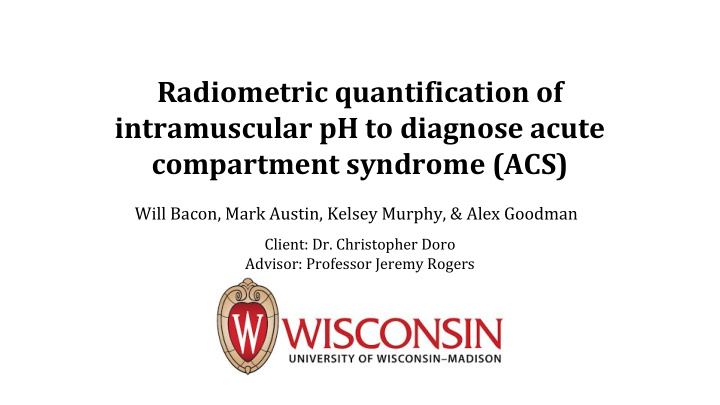



Radiometric quantification of intramuscular pH to diagnose acute compartment syndrome (ACS) Will Bacon, Mark Austin, Kelsey Murphy, & Alex Goodman Client: Dr. Christopher Doro Advisor: Professor Jeremy Rogers
Diagnosing Compartment Syndrome ● Diagnostic issues and challenges of acute compartment syndrome (ACS) ● Current understanding of ACS ● Requirements for ACS technology ○ Continuous biochemical monitoring ○ Ability to reach fascial compartments of varying depths ○ High grade of accuracy ● Comparison of various probe configurations ○ Hydrogel-Dye Microenvironment ○ Reflective pH-reactive adhesive ○ Microdialysis Spectrometer ● Proposed design for diagnosis
Current diagnosis of Compartment Syndrome Intracompartmental Pressure Reading Clinical Examination
35% False-positive diagnosis (Doro etl. al)
Acute Compartment Syndrome pH Glucose [5]
pH as a Biomarker ● Lack of O 2 leads to lactic acid byproduct ● The Bohr Effect ○ %O 2 = pH ● Reactive with a variety of dyes ● Normal pH ~ 7.35 ○ Measurement of relative change to this standard
F500136f05-07-9780323077507.jpg Requirements for ACS Technology ● Continuous biochemical marker monitoring ○ 1 sample/10 minutes ● Depth below skin ○ 1-5 cm ● Standard of care ○ 16 gauge needle max ● Easy to use ● Cheap and disposable [6]
Hydrogel-dye Microenvironment Configuration Control Circuit ● pH indicator dye is immobilized on a hydrogel. Input optical fiber Output optical fiber ● Selectively permeable membrane adhered between indicator dye and hydrogel. Epoxy ● Optical fibers held in place with epoxy glue. ● Intensity of light reflected off Hydrogel Indicator Dye indicator dye correlates to pH. H+ Permeable Membrane
[8] Reflective pH-reactive tape Top View Configuration ● Composed of four layers ○ Two securing adhesive layers [8] ○ One Gold Mesh layer Securing Adhesive ○ One pH indicator dye layer Gold Reflective Mesh ● Tape adhered to commercially pH Sensor Patch available transmissive pH probe. Securing Adhesive ● Transmissivity of light emitted Cross-Sectional View from probe is measured and correlated to pH.
Microdialysis Chamber Configuration ● Microdialysis probe continuously perfused via inlet tube. ● Semipermeable membrane allows analyte to diffuse into probe. ● Dialysate containing analyte sent to analysis chamber via outlet tube. ● Spectrometry performed on outlet tube to determine pH Depiction of Microdialysis process [10]
Design Matrix
Future Work: Phase 1 (Fall Semester) Chemistry Instrumentation ● Dichromatic excitation ● pH indicator ○ ● BCECF Optimizing optical feedback ● Immobilization/encapsulation ● Developing analytical circuit ○ Correlate response, pH
Future Work: Phase 2 (Spring Semester) ● Integrating ‘cuvette’, instrumentation ● Testing ○ Stability of connection ○ Signal collection ○ Calibration against other probes
References and Acknowledgements [1] Anon, (2018). [image] Available at: https://i.pinimg.com/originals/4a/5b/1f/4a5b1f49b7979b859a5757399369e764.jpg [Accessed 5 Oct. 2018]. [2] Anon, (2018). [image] Available at: https://emedicine.medscape.com/article/307668-workup [Accessed 5 Oct. 2018]. [3] Anon, (2018). [image] Available at: https://www.mayoclinic.org/diseases-conditions/chronic-exertional-compartment-syndrome/symptoms-causes/syc-20350830 [Accessed 5 Oct. 2018]. [4] "BCECF", Genecopoeia.com, 2018. [Online]. Available: http://www.genecopoeia.com/product/bcecf/. [Accessed: 02- Oct- 2018]. [5] R. Bizzarri, M. Serresi, S. Luin and F. Beltram, "Green fluorescent protein based pH indicators for in vivo use: A review", Analytical and Bioanalytical Chemistry, vol. 393, pp. 1107 - 1122, 2009. [6] N. Boens, W. Qin, N. Basaric, A. Orte, E. M. Talavera, and J. M. Alvarez-Pez, “Photophysics of the Fluorescent pH Indicator BCECF,” The Journal of Physical Chemistry A, vol. 110, pp. 9334–9343, Jun. 2006. [7] “Bohr Effect Explained: Why Oxygen Is Released in Tissues,” Causes of Cystic Fibrosis: Low O2 in Body and Ion Pumps. [Online]. Available: https://www.normalbreathing.com/CO2-bohr-effect.php. [Accessed: 03-Oct-2018]. [8] Derendorf, H. (2007). A microdialysis probe of concentric design . [image] Available at: https://www.researchgate.net/publication/6369883_AAPS-FDA_Workshop_White_Paper_Microdialysis_Principles_Application_and_Regulatory_Perspectives. [9] https://openi.nlm.nih.gov/detailedresult.php?img=PMC3505898_CRIM.ORTHOPEDICS2011-678525.002&req=4. (2018). [image]. [10] Ocean Optics . Introduction to pH and optical pH sensing. (2018). [11] A. Whitney, R. V. O’Toole, E. Hui, M. F. Sciadini, A. N. Pollak, T. T. Manson, W. A. Eglseder, R. C. Andersen, C. Lebrun, C. Doro, and J. W. Nascone, “Do one-time intracompartmental pressure measurements have a high false-positive rate in diagnosing compartment syndrome?,” Journal of Trauma and Acute Care Surgery , vol. 76, no. 2, pp. 479–483, 2014.
Recommend
More recommend